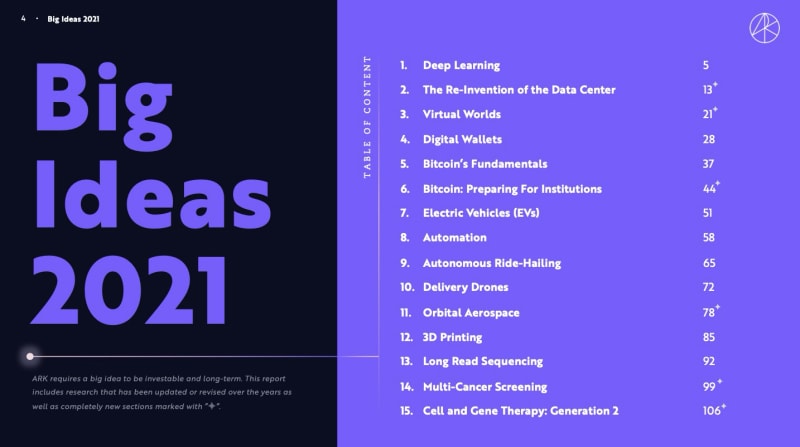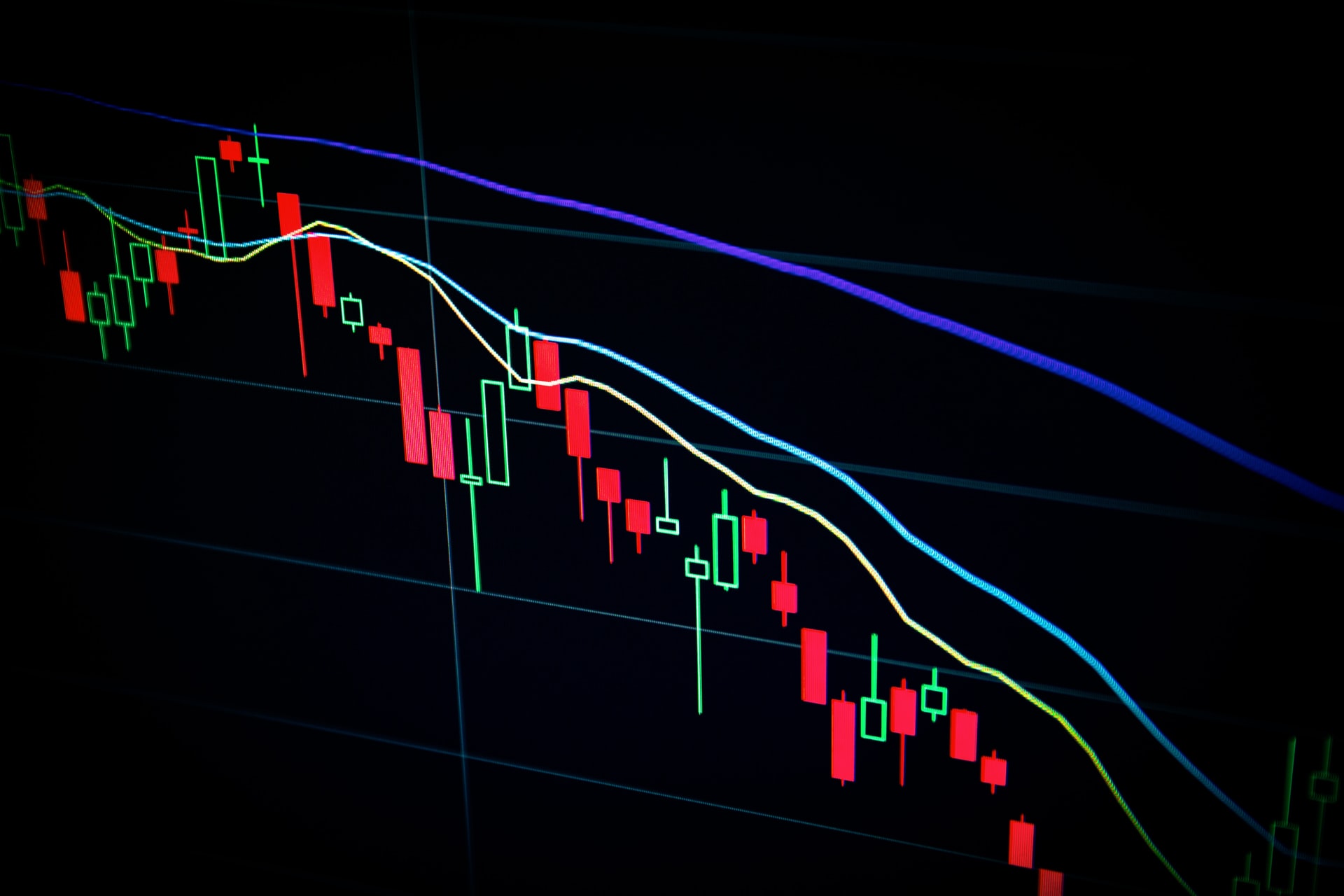ARK invest has published their Big Ideas 2021 report, which is a very interesting read.
ARK’s investment philosophy is to focus on disruptive innovations. There are about 15 ideas they covered in the report. I summarized their expected market size in the following table.
Note:
- Please read the original paper for assumptions, they didn’t publish a consistent format.
- Cells listed as “N/A” mean they didn’t share explicit info.
| Idea | Estimated market cap | In What Year |
|---|---|---|
| Deep Learning | 30 trillion | 2035-2040 |
| Re-Invention of Data Center | 41 billion | 2030 |
| Virtual Worlds | 390 billion | 2025 |
| Digital Wallets | 4.6 trillion | 2025 |
| Bitcoin Value | $840 billion1 | N/A |
| Bitcoin for institutions | 1 trillion | 2025-2030 |
| EV | 40 million | 2025 |
| Automation | 1.2 trillion | 2025 |
| Autonomous Ride-Hailing | 1 trillion | 2030 |
| Drone Delivery | 300 billion | 2030 |
| Orbital Aerospace | 270 billion | N/A |
| Long-Read Sequencing | 5 billion | 2025 |
| Multi-Cancer Screening | 150 billion | N/A |
| Cell and Gene Therapy | 260 billion | N/A |
A lot of these are super exciting fields that I personally also concur with. Let’s take a look at what they are. Since there are 15 of them, I am going to share my thoughts in the next couple of posts.

Deep Learning
ARK believes that deep learning will add $30 trillion to equity market capitalizations during the next 15-20 years.
Deep learning (DL) happens to be the field that I am most familiar with. All my previous and current work involve machine learning, ranking & relevance, recommendation systems, all of which involved deep learning in a certain way. ML has been a heated field in the last couple of years, especially deep learning techniques. It has become a sort of a buzz word that everyone knows.
The bet is based on the fact that DL has been powering some of the most promising technologies, including conversation computers (e.g., Alexa), self-driving cars (Waymo, Tesla), and popular consumer apps (TikTok).

One of the most innovative breakthroughs is the GPT-3 model, which brings AI to accomplish tasks that were used to only achievable by humans, such as writing emails or even code.
Meanwhile, due to the inherent computational resource required from deep learning, there is a huge demand for new chips that specialized in DL. There will also be a boom to AI chips.
My confidence: 9/10. While I haven’t seen too many standalone AI companies are making huge success, existing companies such as FB and Google has been working in this area for years and has already deployed DL to a vast array of things. I have no doubt it will lead to more large-scale automation to replace humans from mundane tasks.
Data Center Reinvented
In the data center, we believe accelerators, dominated by GPUs, will become the dominant processors for new workloads, growing 21% at an annual rate to $41 billion by 2030.
Intel has been dominating the CPU market for years, until recently. It is pointed out that:
Intel delayed its 10nm processor by four years, allowing its competitors—TSMC and AMD—to lead the market in 2020.
As of 2020, Intel still has not shipped a 10nm server chip. A full generation ahead of Intel, TSMC is mass producing 5nm processors.
A major event recently, is that Apple has switched the Mac from x86 to ARM CPU (Apple M1).
We believe that the combination of ARM and RISC-V will move from 0% market share in 2020 to 71% of the server market by 2030.
My confidence: 6/10. I think there are two main questions here. First is that why Intel is not making much progress to deeper nodes (5nm and beyond). It could very well be that Intel can overcome some of its issues and come back. Secondly, it is clearly a trend that ARM/RISC is coming back, but it’s hard to tell whether it can fully disrupt Intel’s architecture. Further investigation needs to be done to examine this statement:
According to ARK’s research, by 2030 most developer PCs could be powered by ARM CPUs, marking the end of the Intel x86 era.
Virtual Worlds
This consists of video games, augmented reality, and virtual reality.
According to our research, revenue from virtual worlds will compound 17% annually from roughly $180 billion today to $390 billion by 2025.
Key takeaways:
- The video game industry is booming, the monetization is increasing.
- Companies like Snapchat, Facebook are investing in augmented reality
- VR could be a reality by 2030 according to the current projection
Based on our research, the global gaming market will increase at a 16% compound annual rate during the next five years, from $175 billion in 2020 to roughly $365 billion by 2025.
The AR & VR markets will grow at a 59% compound annual rate during the next five years, from $3 billion to $28 billion in 2025
My confidence: 7/10. The gaming industry is indeed coming strong. Compared to traditional gaming, there are two significant trends:
- Online gaming and live streaming have become a “commodity”. With the advent of streaming, people can enjoy gaming by watching others play, rather than themselves playing it.
- Competitive gaming becomes a real thing. There are worldwide competitions and grand prizes for popular games. There are also emerging degrees in gaming as well as professional gamers.
However, not quite confident about AR/VR. AR/VR hyped in the past few years, but it seems still not benefiting enough people. There aren’t many widely available or popular applications so far.
Digital Wallets
According to ARK’s research, digital wallets are valued between $250 and $1,900 per user today but could scale to $20,000 per user, representing a $4.6 trillion opportunity in the US by 2025.

The paper shared some surprising numbers:
- China’s mobile payment volume is estimated at $36 trillion, 3x the size of China’s GDP in 2020.
- US digital wallet users are surpassing the number of deposit accounts. It took Chase about 30 years to get to 60 million Annual Active users (AAUs), while it only took Square and Venmo less than 10 years.
- Digital wallet users’ acquisition cost is really low compared to traditional bank accounts.
- ARK estimates each digital wallet user worth roughly $19900 (!). To date, current valuation per customer is discounted (undervalued), e.g., Venmo = $250, Cash App = $700. This means they are undervalued and poses a huge opportunity.
My confidence: 9/10. China has been leading the way in the mobile payment / digital wallet playfield. If you’ve been to China, literally everyone uses either WeChat/Taobao for payment, from larger purchases in department stores to your neighborhood stores. There is a joke that even the beggars in the street have QR code plates for you to scan and tip for your convenience. I have no doubt the US and other places around the world will catch up due to its huge convenience.
Bitcoin’s Fundamentals
As bitcoin’s price hit an all-time high, ARK’s research indicated that its network fundamentals remained healthy.
If all S&P 500 companies were to allocate 1% of their cash to bitcoin, ARK estimates that its price would increase by approximately $40,000.
ARK believes that even the price of bitcoin has hit an all-time high, its fundamentals remained healthy. Some evidence includes: Bitcoin holder has been more long-term focused, rather than speculative nature (e.g., day trading).

My confidence: 4/10. Hmm, I have lower confidence in this one. Some of the arguments aren’t particularly convincing. For example, ARK thinks 60% of bitcoin’s supply had not moved in more than a year, then it means people are more willing to hold. However, this should be normalized by the individuals, as this could just mean that some of the bigger players have been longing and dominates the 60%. Also, bitcoin is relatively new and only enters the public’s eyes in a recent years, the people that are holding it > 5 years will only reach > 5 years when they entered early enough.
Another flaw IMO is that the cost basis. It hits an all-time high, and they think it suggests “early investors are taking profits, while newer investors are establishing positions and creating higher price support levels”. This is not a very strong argument to its fundamental value, but simply supply and demand has changed. As Ray Dalio has mentioned in his recent article, he recognizes there is a need for bitcoin as it has similar attributes as gold that is limited in supply, but one has to estimate the demand to estimate its price.
Bitcoin: Preparing for institutions
As our analysis suggests, it could scale from roughly $500 billion to $1-5 trillion in network capitalization during the next five to ten years.
More regulations and banks are starting to accept bitcoin. Some companies started to invest in bitcoin, most notably Square, which invests 1% of assets in bitcoin.
One interesting data ARK showed here is the correlation matrix between bitcoin and other asset classes. It is believed that bitcoin has a low correlation with these asset classes, which suggests that it can be a potential asset to invest in.

Another observation is that Bitcoin’s trading volume is already comparable to that of a large-cap stock.
ARK ran a Monte-Carlo simulation of portfolios and found that the efficient frontier suggests the optimal Sharpe ratio is achieved at 2.55% - 6.55% bitcoin investments.

My confidence: 5/10. While I agree that it’s very possible and likely that Bitcoin is onto something, e.g., getting recognized just as a currency similar to USD, or gold, there are two major risks that I don’t feel very comfortable about:
- what’s the realistic and practical usage of bitcoin, and whether other cryptocurrencies will “solve” its supply issue
- how will the governments regulate bitcoin. As Ray Dalio mentioned in his article, governments may want to probe into the holdings due to reasons such as national security, money laundering, how can it protect against people’s privacy which is one of its selling points.
In conclusion, there are just too many risks associated and I would not invest in something that I don’t feel I have a good understanding of.
-
I derived this by: price estimated at $40,000, and there are a total of 21 million bitcoins. ↩




Comments